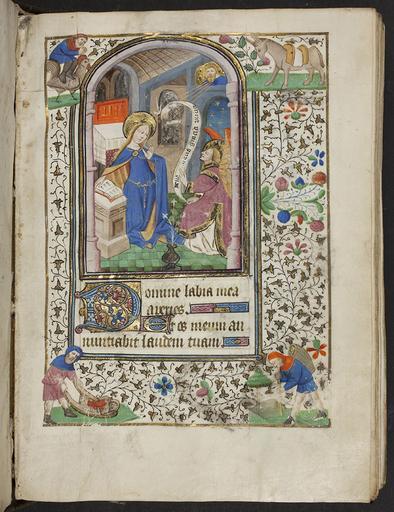MAKE A MEME
View Large Image

| View Original: | Book_of_Hours,_f.29r,_(184_x_133_mm),_15th_century,_Alexander_Turnbull_Library,_MSR-02..jpg (788x1024) | |||
| Download: | Original | Medium | Small | Thumb |
| Courtesy of: | www.flickr.com | More Like This | ||
| Keywords: medieval renaissance annunciation illumination book of hours bookofhours picture frame This Book of Hours was copied in Eastern France between 1425 and 1475. The miniature pictured here is one of twelve large miniatures in gold frames, arched at the top and with three or four lines of text underneath. This leaf at the beginning of Matins for the Hours of the Virgin shows the Annunciation, with the angel appearing before the Virgin Mary to tell her that she has been chosen to bear the Son of God. The full ivy-leaf border includes a saddled donkey, a man on a cock’s back, a man ploughing, and a man with a basket on his back. Immediately below the miniature is a 3-line initial decorated in red and blue with white tracery on a gold ground. The second and last lines of text are completed with line-fillers. The Book of Hours was a medieval prayer book used by laymen for private devotion. These books were created for both men and women, but their place in female devotion is particularly noteworthy. The text centres on the Hours of the Virgin, a series of prayers to be said at the eight canonical hours of Matins, Lauds, Prime, Terce, Sext, None, Vespers, and Compline. This Book of Hours was copied in Eastern France between 1425 and 1475. The miniature pictured here is one of twelve large miniatures in gold frames, arched at the top and with three or four lines of text underneath. This leaf at the beginning of Matins for the Hours of the Virgin shows the Annunciation, with the angel appearing before the Virgin Mary to tell her that she has been chosen to bear the Son of God. The full ivy-leaf border includes a saddled donkey, a man on a cock’s back, a man ploughing, and a man with a basket on his back. Immediately below the miniature is a 3-line initial decorated in red and blue with white tracery on a gold ground. The second and last lines of text are completed with line-fillers. The Book of Hours was a medieval prayer book used by laymen for private devotion. These books were created for both men and women, but their place in female devotion is particularly noteworthy. The text centres on the Hours of the Virgin, a series of prayers to be said at the eight canonical hours of Matins, Lauds, Prime, Terce, Sext, None, Vespers, and Compline. | ||||